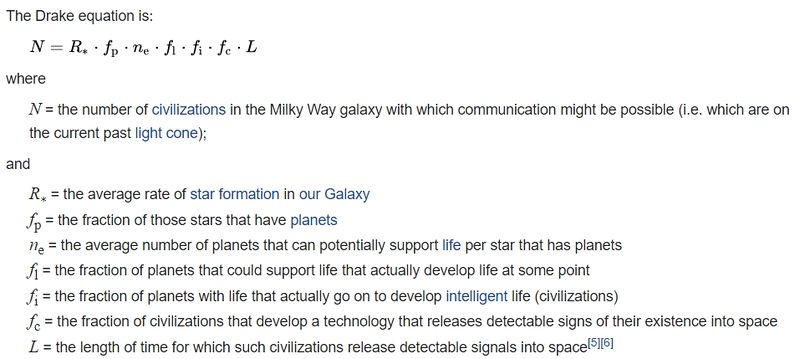Extraterrestrial life
Extraterrestrial life, colloquially referred to as alien life, is life that may occur outside of Earth and which did not originate on Earth. No extraterrestrial life has yet been conclusively detected, although efforts are underway. Such life might range from simple forms like prokaryotes to intelligent beings, possibly bringing forth civilizations that might be far more advanced than humankind. The Drake equation speculates about the existence of sapient life elsewhere in the universe. The science of extraterrestrial life is known as astrobiology.
Speculation about the possibility of inhabited "worlds" outside the planet Earth dates back to antiquity. Multiple early Christian writers discussed the idea of a "plurality of worlds" as proposed by earlier thinkers such as Democritus; Augustine references Epicurus's idea of innumerable worlds "throughout the boundless immensity of space" (originally expressed in his Letter to Herodotus) in The City of God. In his first-century poem De rerum natura (Book 2:1048–1076), the Epicurean philosopher Lucretius predicted that we would find innumerable exoplanets with life forms similar to, and different from, the ones on Earth, and even other races of man.[citation needed]
Pre-modern writers typically assumed that extraterrestrial "worlds" would be inhabited by living beings. William Vorilong, in the 15th century, acknowledged the possibility that Christ could have visited extraterrestrial worlds to redeem their inhabitants. Nicholas of Cusa wrote in 1440 that the Earth was "a brilliant star" like other celestial objects visible in space, which would appear similar to the Sun from an exterior perspective due to a layer of "fiery brightness" in the outer layer of the atmosphere. He theorized that all extraterrestrial bodies could be inhabited by men, plants, and animals, including the Sun. Descartes wrote that there were no means to prove that the stars were not inhabited by "intelligent creatures," but their existence was a matter of speculation. The writings of these thinkers show that interest in extraterrestrial life existed throughout history, but it is only recently that humans have had any means of investigating it.
Since the mid-20th century, active research has taken place to look for signs of extraterrestrial life, encompassing searches for current and historic extraterrestrial life, and a narrower search for extraterrestrial intelligent life. Depending on the category of search, methods range from the analysis of telescope and specimen data[8] to radios used to detect and send communication signals.[citation needed]
The concept of extraterrestrial life, and particularly extraterrestrial intelligence, has had a major cultural impact, especially extraterrestrials in fiction. Over the years, science fiction has communicated scientific ideas, imagined a wide range of possibilities, and influenced public interest in and perspectives on extraterrestrial life. One shared space is the debate over the wisdom of attempting communication with extraterrestrial intelligence. Some encourage aggressive methods to try to contact intelligent extraterrestrial life. Others—citing the tendency of technologically advanced human societies to enslave or wipe out less advanced societies—argue that it may be dangerous to actively call attention to Earth.
Drake equation
The Drake equation is a probabilistic argument used to estimate the number of active, communicative extraterrestrial civilizations in the Milky Way Galaxy.
The equation was formulated in 1961 by Frank Drake, not for purposes of quantifying the number of civilizations, but as a way to stimulate scientific dialogue at the first scientific meeting on the search for extraterrestrial intelligence (SETI). The equation summarizes the main concepts which scientists must contemplate when considering the question of other radio-communicative life. It is more properly thought of as an approximation than as a serious attempt to determine a precise number.
Criticism related to the Drake equation focuses not on the equation itself, but on the fact that the estimated values for several of its factors are highly conjectural, the combined multiplicative effect being that the uncertainty associated with any derived value is so large that the equation cannot be used to draw firm conclusions.
Chat rooms • What links here • Copyright info • Contact information • Category:Root

